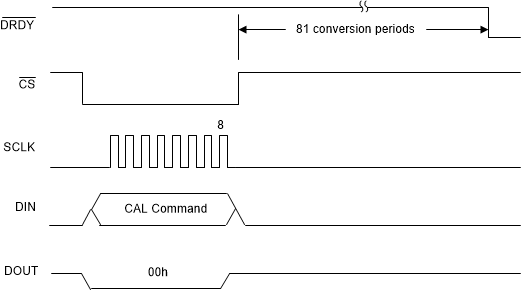SBASAW0 February 2024 ADS1288
PRODUCTION DATA
- 1
- 1 Features
- 2 Applications
- 3 Description
- 4 Pin Configuration and Functions
-
5 Specifications
- 5.1 Absolute Maximum Ratings
- 5.2 ESD Ratings
- 5.3 Recommended Operating Conditions
- 5.4 Thermal Information
- 5.5 Electrical Characteristics
- 5.6 Timing Requirements: 1.65V ≤ IOVDD ≤ 1.95V and 2.7V ≤ IOVDD ≤ 3.6V
- 5.7 Switching Characteristics: 1.65V ≤ IOVDD ≤ 1.95V and 2.7V ≤ IOVDD ≤ 3.6V
- 5.8 Timing Diagrams
- 5.9 Typical Characteristics
- 6 Parameter Measurement Information
-
7 Detailed Description
- 7.1 Overview
- 7.2 Functional Block Diagram
- 7.3 Feature Description
- 7.4 Device Functional Modes
- 7.5
Programming
- 7.5.1 Serial Interface
- 7.5.2 Conversion Data Format
- 7.5.3
Commands
- 7.5.3.1 Single Byte Command
- 7.5.3.2 WAKEUP: Wake Command
- 7.5.3.3 STANDBY: Software Power-Down Command
- 7.5.3.4 SYNC: Synchronize Command
- 7.5.3.5 RESET: Reset Command
- 7.5.3.6 Read Data Direct
- 7.5.3.7 RDATA: Read Conversion Data Command
- 7.5.3.8 RREG: Read Register Command
- 7.5.3.9 WREG: Write Register Command
- 7.5.3.10 OFSCAL: Offset Calibration Command
- 7.5.3.11 GANCAL: Gain Calibration Command
-
8 Register Map
- 8.1
Register Descriptions
- 8.1.1 ID/SYNC: Device ID, SYNC Register (Address = 00h) [Reset = xxxx0010b]
- 8.1.2 CONFIG0: Configuration Register 0 (Address = 01h) [Reset = 92h]
- 8.1.3 CONFIG1: Configuration Register 1 (Address = 02h) [Reset = 10h]
- 8.1.4 HPF0, HPF1: High-Pass Filter Registers (Address = 03h, 04h) [Reset = 32h, 03h]
- 8.1.5 OFFSET0, OFFSET1, OFFSET2: Offset Calibration Registers (Address = 05h, 06h, 07h) [Reset = 00h, 00h, 00h]
- 8.1.6 GAIN0, GAIN1, GAIN2: Gain Calibration Registers (Address = 08h, 09h, 0Ah) [Reset = 00h, 00h, 40h]
- 8.1.7 GPIO: Digital Input/Output Register (Address = 0Bh) [Reset = 000xx000b]
- 8.1.8 SRC0, SRC1: Sample Rate Converter Registers (Address = 0Ch, 0Dh) [Reset = 00h, 80h]
- 8.1
Register Descriptions
- 9 Application and Implementation
- 10Device and Documentation Support
- 11Revision History
- 12Mechanical, Packaging, and Orderable Information
Package Options
Mechanical Data (Package|Pins)
- RHB|32
Thermal pad, mechanical data (Package|Pins)
- RHB|32
Orderable Information
7.4.5.3 Calibration Procedure
ADC calibration is performed by ADC calibration commands or manual calibration. The calibration procedure is as follows:
- Select the PGA or buffer operation, input channel, and PGA gain condition for calibration.
- Preset the OFFSET register = 000000h and the GAIN register = 400000h.
- Disable the high-pass filter for offset
calibration. Short the inputs to the system, or use the input MUX to provide the
input short. A system-level input short yields more accurate calibration. After
the input settles, either send the OFSCAL command or perform a manual
calibration.
- OFSCAL command. After the command is sent, DRDY is driven low 81 conversion periods later to indicate calibration is complete. The OFFSET register is updated with the new calibration value. As shown in Figure 7-21, the first data output uses the new OFFSET value.
- Manual calibration. Wait at least 64 conversions for the digital filter to settle then average a number of data points to improve calibration accuracy. Write the value to the 24-bit OFFSET register.
- Apply a gain calibration voltage. After
the input settles, either send the GANCAL command or perform a manual calibration.
- GANCAL command. Apply a positive dc full-scale calibration voltage. After the command is sent, DRDY is driven low 81 conversion periods later to indicate calibration is complete. The ADC calculates GAIN such that the full-scale code is equal to the applied calibration signal. As shown in Figure 7-21, the first data output uses the new GAIN value.
- Manual calibration. Apply an ac signal coherent
to the sample rate or dc calibration signal that are slightly below
full-scale (for example, 2.4V for gain = 1). Using a calibration signal
less than the full-scale range prevents clipped output codes that
otherwise lead to incorrect calibration. Wait 64 conversions for the
digital filter to settle then average a number of data points to improve
calibration accuracy. For ac-signal calibration, use a number of
coherent signal periods to compute the RMS value.
Equation 7 computes the value of GAIN for manual calibration.
Equation 7.
 Figure 7-21 Calibration Command
Figure 7-21 Calibration Command